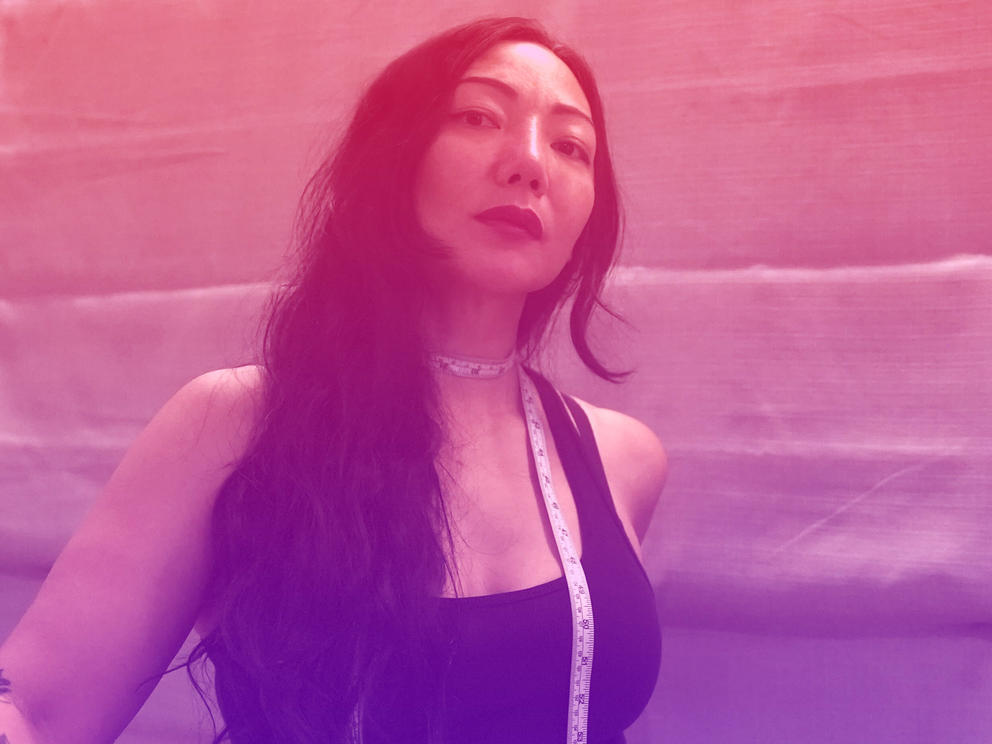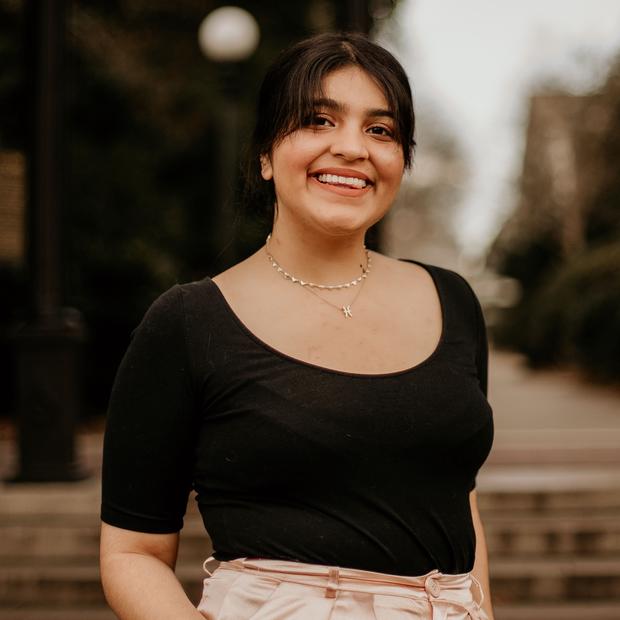Born in the Philippines, Hess grew up in Vancouver, B.C., where her clothing design journey began in the same way many young people get started on a creative project: Her mom made her do it.
After finding out Hess was shoplifting clothes at 15, her mother put her in sewing classes. Soon Hess was making custom clothes for her family and taking commissions from her friends.
This interview is part of our Summer Artist Talks. Read more artist Q&As in the series.
With her eye for visual art, Hess took classes at Vancouver Film School as a young adult. That sparked her interest in graphic design and taught her skills in Photoshop and HTML coding, which she honed at her first job in tech, in 1998.
Hess continued to pursue UX design when she moved from Vancouver to Seattle in 2006. Then in her early 20s, Hess still found herself drawn to design clothing. A soggy bike commute from Georgetown to Pioneer Square inspired Hess to create a cyclist-friendly line of military-style raincoats called Made in SoDo, which debuted in 2010.

The coats were made from waxed canvas with add-on options like detachable cotton linings, hoods and moisture-resistant mesh. Hess describes creating that collection as her fashion-design school — it was during those four years that she expanded her craft and learned how to make custom clothing into a business.
But in 2014 a unique opportunity arrived, and Hess switched gears back to tech. She co-founded an ahead-of-its-time dating app called Siren (now defunct) that aimed to put women in control of app interactions.
“I always meant to come back to the coats with Made in SoDo, but I ended up on this tech journey,” Hess says.
Still, Hess didn’t leave fashion entirely. That same year she became a seasonal costume designer for Café Nordo — Seattle’s long-running dinner theater. Her creations for Nordo performers included gold and sparkly checkered jackets, angelic white corsets and blue puff-sleeved dresses. These garments appeared to hold stories within the fabrics, amplified by the actors who donned them each night.
But her fashion designer dreams took a backseat to UX design until last year, when, after some personal health scares, she experienced a reckoning.
“If we only have X amount of time, am I doing the thing that I love?” Hess remembers asking herself. She decided to dedicate herself to fashion design full-time.
Now 46, this fall she’ll launch a brand-new studio line called House of Daggers. While again focused on outerwear, these garments depart from the practicality of Made in SoDo and take a bolder approach. With high collars and future-noir vibes, it’s easy to imagine the coats worn by a glamorous spy on a top-secret mission.
The new studio’s name is inspired by the cultural significance of traditional Filipino daggers, particularly the kris: a pre-colonial, asymmetrical knife. The kris had many uses — as a secondary weapon in battle, an everyday self-defense tool for commoners and also a ceremonial accessory during peaceful times.
It makes sense that Hess is symbolizing this new era in her career with an adaptable weapon — power reverberates in these designs through sharp angles, moody colors and sleek fits.
On the brink of adding her own spin to Seattle’s long history of outerwear designers (see Filson and Eddie Bauer), Hess spoke with Crosscut about how her relationship with fashion design has evolved and how garments can tell stories.
This interview has been edited for length and clarity.
Crosscut: How did you get into fashion?
Hess: I started learning how to make clothes because I was stealing clothes. And my mom was like, “You’re gonna learn how to make clothes.”
She put me in a bunch of sewing classes when I was 15, and then I just started making clothes. My sister was my first muse — I made her any kind of dress she needed for school dances. [Also,] I had a bunch of break-dancer friends who commissioned me to make their performance outfits. That was actually my first commission. I’m sure I made, like, $50.
Your first collection, Made in SoDo, featured custom-made raincoats designed specially for bicyclists. What inspired it?
I think it was 2010. I was living in Georgetown, and I worked in Pioneer Square, so I just rode my bike. But it was raining. I was like, whatever, I'll just look for a raincoat. I was surprised — I couldn't find a style or a cut that I really liked.
I started just designing my own. At the time, I was living in an arts co-op. People saw [the coat], and it just kind of became a business.
When I was making the coats for Made in SoDo, it was really like, “Oh, I like this look, how do I make it look better? How do I make it feel good for people?” Made in SoDo was all custom, and that was my fashion-design school. That was my 101. I learned so much about pattern drafting and how to make things fit for people.
The market that I really love is outerwear, and I’m sure it’s because I live in Seattle. I love encouraging people to be outside. I want to keep people warm. Anytime it was shitty weather, I was like, “Yes! People are gonna feel excited to put their jacket on!”
This summer you’ve been taking your designs to a new level. What are you focused on?
I am studying with a master tailor [Andrew Ramroop] from Savile Row [in London]. I found him during the pandemic — while everyone else was making sourdough bread, I was like, “I need to make a coat.” I ran into an issue in this pattern that I was working on, and through looking for a course, I found him and he ended up accepting me as a mentee.
I’ve been making outerwear for a long time and I feel like I’ve earned my outerwear-designer stripes. But after my studies with my mentor, I would be very honored about being able to call myself a coatmaker. There’s some tailoring techniques that take you to that next level, which I’m slowly rolling into my designs.
I’m learning these Old World techniques — this is how clothing has been made for centuries before fast fashion happened.

You’ve also worked in costume design. What drew you to theatrical work?
I got into costume design because of these two really close friends of mine who founded Café Nordo, which is a dinner theater in Pioneer Square. I got introduced to … being a part of this bigger picture with dressing actors and working in tandem with the set design and the props, [and] I was like, “This is really, really cool.”
It’s hard not to get sucked into storytelling. The way that I design is as a storyteller, as a costume designer.
Has your work in tech as a graphic and product designer influenced your approach to fashion design?
When I started off in graphic design, it was marketing and branding. But in 2007, I moved into what we now know as product design, UX design … [and] I was like, “Whoa, this is so much more fun for me.” Because you’re really thinking about the user, the person. What problems are they running into? What are you trying to solve for?
The goal for both software products and for the clothes that I’m making is for it to feel effortless and easy. When something fits you really well, you don’t think about it.
This is something that I saw when I was making costumes for actors — when they put your stuff on and then all of a sudden, they transform into the character. They’re not even thinking about their clothing — they’re just able to perform. So I think the biggest overlap is it’s still all about the person that you're making something for.
Made in SoDo was all custom sizing, and House of Daggers will offer both custom and standard sizing. Why do you choose to tailor-make pieces?
In the States, [getting] things tailor-made is really expensive. I would say that would be my biggest pet peeve about the fashion industry: Things that are made to last, made well, made to fit your body [aren’t] super-accessible for everyday people. The things that are accessible don’t last, and it creates a bigger problem with the environment.
I’m trying to figure out a way to get my ready-to-wear options in proportions that are flattering and work for everyone. [But] for House of Daggers, there will always be a custom option. I love the interaction with people, the look on their face when things fit them really well. It’s an important part of my design process.
How does that impact the affordability of the pieces?
The things that are handmade take time, and I really want everyone that works for me to make a good living. But I also am trying to find that balance of making these pieces affordable. The coats in Made in SoDo ranged anywhere from $250 to about $750 — for a custom item, not that expensive.
When things are made well, they last for a really long time. These pieces should be something that you can hand [down] to someone else. The tailoring techniques that I’m learning are also a big part of it — you should be able to take your garments in and out, in and out.
At the end of the day, it’s just clothing. You shouldn’t have to take out a loan. But I do value the time that it takes. It’s a balance that I’m still sorting out.
You’ve described your debut collection for House of Daggers, called “Lethal,” as future noir-inspired. Can you expand on that?
I got really obsessed with Ryan Gosling’s coat from Blade Runner 2049. I loved that collar. I’m definitely drawn to that sci-fi, adventure, action kind of vibe. I really liked that kind of secret agent sci-fi look.
There’s different versions of futuristic fashion, and the future-noir thing for me is that it’s definitely sci-fi, but there’s also some kind of mystery.
How do you feel like you’ve evolved and changed as a designer in the past decade?
With Made in SoDo, I was really designing for function. Now when I design, there’s always a little bit of a story behind it.
I am putting more of my identity [into the designs]. I feel like I’m from the Pacific Northwest. I feel really strongly connected to Georgetown. I feel really strongly connected — more so than ever — to my Filipino heritage. As a designer, I feel like my voice is becoming much stronger.
Get the latest in local arts and culture
This weekly newsletter brings arts news and cultural events straight to your inbox.



